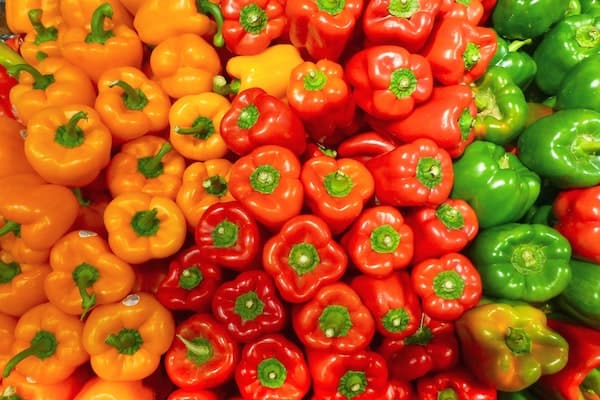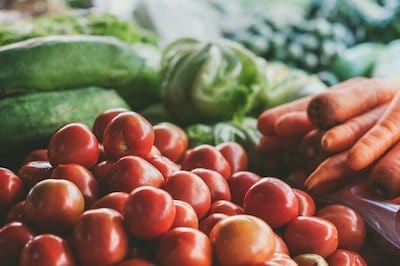How to grow bell peppers in containers
A step-by-step guide to growing bell peppers in pots
If you’ve ever grown a garden (in containers or in the ground), there’s a good chance you’ve grown bell peppers! Along with tomatoes and herbs like basil and thyme, they’re a popular staple for a reason. I’ll give you all the details about how to grow bell peppers in containers below.
Did you know the red, orange and yellow bell peppers you see in the grocery store are actually ripened green bell peppers??
Bell peppers are considered sweet peppers, as opposed to hot varieties like jalapeños. Green, while most common, are actually the least sweet as they aren’t fully ripened. Red peppers are from the same plant, sweeter because they’re left on the plant to ripen as they turn red.
This is why they cost more at the store – they take longer to grow before harvesting! See the growing tips below to learn how to get lots of green fruit from your bell pepper plant before leaving a few on longer to get a sweet red option from the same plant.
This post may contain affiliate links. If you buy something through these links, we may earn a small commission at no cost to you.

How to grow bell peppers from seeds
Bell peppers can be started from seeds, but they love to be warm, so it’s best to start them indoors about 8-10 weeks before final frost. Seedlings can take anywhere several weeks to appear, so patience is key.
Again, warmer is better, and you’ll see better results if you use a heat mat or heated propagator. These things are amazing … I’ve seen them make the difference between struggling seedlings and strong ones.
My favorite is the VIVOSUN Waterproof Seedling Heat Mat. I have two and pack a bunch of herb and veggie seed trays on them in a windowsill to get the early seeds started each season. They’re so easy to use and clean. Bestsellers (and my top recommendation) for good reason!
Bell pepper seeds may be planted outdoors, but there must be no risk of cold weather. It’s best to wait 2-3 weeks after last frost before planting seeds outside. Keep in mind you’ll want to have a long growing season ahead of you, as peppers can take two or more months to be ready for harvest.
How to plant bell peppers
Pepper seeds are small and should be planted about ¼ inch deep, unless your seed packet says otherwise.
If you’re using seedlings, plant them in high-quality potting mix up to their lowest leaves, just like tomatoes.
Seedlings need to be about 18-24” apart, so you will likely end up with just one plant per container.
For seedlings (whether grown from seed or bought at a garden store or nursery), wait until 2-3 weeks after last expected frost to plant outdoors.
Bell pepper plants love sun, so when it’s time to plant outside, select a sunny spot that receives at least 6 hours of sun each day.

Best varieties of bell peppers for containers
As I mentioned above, green bell peppers are the early ripe stage of most bell pepper plants. The red, orange and yellow are simply left on the plant longer to ripen more, which makes them sweeter.
Red: California Wonder
Orange: Orange Sun
Yellow: Golden California Wonder
Mix (produces red, yellow and orange on the same plant): Sweet Bell Blend
Purple: Purple Beauty
There are also miniature varieties like Baby Belle and Yum Yum Gold. Both produce smaller round or elongated fruit, different than the typical bell pepper shape but with similar flavor. I’ve grown Yum Yum Gold and can vouch for the sweetness!
Best containers for growing bell peppers
A single bell pepper plant will do well in a container about 9-12 inches diameter. Make sure to use heavier, larger pots that won’t topple over as the plants grow taller.
When you plant seedlings, also put in a stake, tomato cage or trellis. Sweet peppers can get top-heavy or fall over sideways if they don’t have support. Installing the stake or cage early will prevent root damage, so don’t wait!
How to grow bell peppers in pots
Germination can take 2-5 weeks, and then it can take another 60-90 days to harvest. Peppers need a long growing season, so be sure to be prepared for this!

Watering instructions
It’s very important to have well-draining soil as peppers don’t like their roots to be sitting in water.
Bell peppers like a good soaking, but let them dry out a bit between waterings. It could be a week before they need more, but keep an eye on them when it is especially hot or sunny. You don’t want to underwater and weaken them — it makes them more susceptible to pests. If the leaves start to droop, they need water stat!
Fertilizer instructions
- Peppers are like tomatoes and enjoy high potassium for flower production and fruit bearing. I highly recommend Jobe’s Organics slow release fertilizer … you just mix in a handful when you plant. So easy and it makes a difference.
- Either way, make sure you cut back on nitrogen-heavy fertilizer as soon as you see fruit developing. Nitrogen boosts foliage growth but can hinder fruit.
- Peppers prefer a more neutral soil, averaging 6-7 pH.
Common bell pepper pests
- Spider mites and aphids are something to check your leaves for. You can deter aphids by planting strong smelling herbs in nearby containers. If they show up, try frequently shaking or spraying them off the leaves.
- Blossom end rot can pop up if you aren’t keeping the plants watered. On the other end of the spectrum, root rot can become a problem if your soil isn’t well-drained. Make sure your container has adequate drainage (at least one or two drainage holes in the bottom) and use high-quality potting mix with plenty of organic matter.
- Avoid re-using pots that recently contained other nightshades like tomatoes, potatoes and eggplant. This can leave them open to disease carried over from previous seasons. This might not be as much of an issue if you sterilize pots between seasons, but if you have options to rotate, I would still rotate them either way.
How many bell peppers per plant?
You can expect as many as 5-10 bell peppers per healthy plant. The key here is to pick them as soon as they are ready to encourage the plant to produce more flowers rather than sending energy to the fruit.
Are there male and female peppers?
While you might have heard the thing about three bumps on the bottom is a male pepper while four is a female, with differences in flavor and use … it’s not true. Peppers are gender neutral! Differences in flavor and use (like raw or cooked) are linked to the variety and growing conditions.
When to pick bell peppers
Sweet peppers are ready when they are shiny and firm. If you like them green, pick as soon as they’re ready. Peppers that are left to turn red should taste sweeter, but it is a tradeoff then as you will have fewer peppers overall by leaving these on the plant to ripen.
It is best to “pick” your bell peppers by using scissors or gardening shears to snip them off with a little bit of stem attached to the plant. If you try and pluck them off by hand, you risk damaging the plant side of the stem.
Now that you know how to grow bell peppers in pots, you should try it this season! They’re a great addition to any container garden.

More ideas for your veggie container garden:
- Veggies that grow well together in containers
- Growing zucchini in containers
- Growing okra in pots
- Growing pumpkins in containers
- How to grow green beans in a pot
- Fall and winter vegetables for container gardens
- How to grow garlic in pots
- Growing jalapeños in pots
- Growing corn in containers
- Growing beets in containers
- How to grow edamame







The best time to plant peppers is typically April through June, when soil temperatures are warming and there is no risk of frost. Knowing when to plant peppers in Southern California is important because they are sensitive to cold and a sudden drop in soil temperature could adversely affect their development.
I agree with you, growing peppers from seeds is indeed a long process, but I like to start them am early as possible. I plant my seeds in December and start harvesting at the beginning of June. I also grow a few European varieties that I cannot find at any nursery, so starting from seeds is my only option.